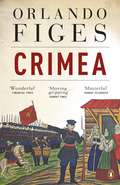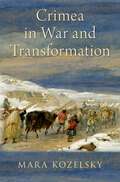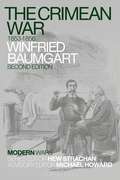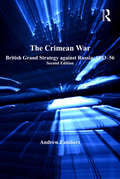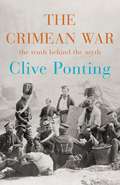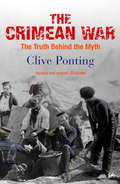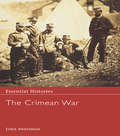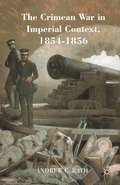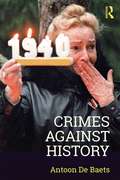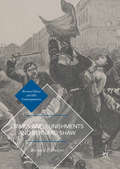- Table View
- List View
Crimea: The Last Crusade
by Orlando FigesThe terrible conflict that dominated the mid 19th century, the Crimean War killed at least 800,000 men and pitted Russia against a formidable coalition of Britain, France and the Ottoman Empire. It was a war for territory, provoked by fear that if the Ottoman Empire were to collapse then Russia could control a huge swathe of land from the Balkans to the Persian Gulf. But it was also a war of religion, driven by a fervent, populist and ever more ferocious belief by the Tsar and his ministers that it was Russia's task to rule all Orthodox Christians and control the Holy Land.Orlando Figes' major new book reimagines this extraordinary war, in which the stakes could not have been higher and which was fought with a terrible mixture of ferocity and incompetence. It was both a recognisably modern conflict - the first to be extensively photographed, the first to employ the telegraph, the first 'newspaper war' - and a traditional one, with illiterate soldiers, amateur officers and huge casualties caused by disease. Drawing on a huge range of fascinating sources, Figes also gives the lived experience of the war, from that of the ordinary British soldier in his snow-filled trench, to the haunted, gloomy, narrow figure of Tsar Nicholas himself as he vows to take on the whole world in his hunt for religious salvation.
Crimea and the Black Sea: An Environmental History (Environmental History and Global Change)
by Carlos CordovaCrimea has a rich and varied history. Mentioned in the writings of Strabo, Herodotus and Pliny the Elder, it was colonized by the Huns, the Goths and the Mongols and was part of the Roman, Byzantine and Venetian empires, until it annexed by Russia in the eighteenth century. It suffered in the Crimean War, saw bloody battles in the Second World War and was transferred to the Ukraine by Khrushchev in the 1950s. Most recently it has drawn international attention as it was once more annexed by Russia in its dispute with Ukraine.The environmental history of Crimea is similarly complex. Formerly known as the Tauric Peninsula, its landscape of plains, piedmont and mountains, is surrounded to the east by the Azov Sea, to the north by the Sivash lagoonal system and to the south and west by the Black Sea. The Black Sea in particular has had a major impact on nearly all aspects of Crimea's natural and cultural history, from the impact of its flooding in prehistoric times to the environmental pollution problems of the modern era. Carlos Cordova explains the making of Crimea's natural environment, from its geology and relief to its climate and soils. He explores the rich flora and fauna of the peninsula, including the biogeographical isolation of Crimea, its endemic and relict species, as well as the struggle to protect species and their habitats. He details the transformation of the landscape brought about by Greek farmers and other Mediterranean groups, as well as the marked changes resulting from Khrushchev's Virgin Lands Campaign, which saw virtually all the steppe trurned into cropland. The development of the south coast – the so-called Russian Riviera – as a tourist destination and the pollution brought about by the development of agriculture and industry are also included. The strategic importance of Crimea as a site for many Russian naval bases has meant that there has been little access to the region and it is poorly known in the west. With the collapse of the Soviet Union the situation changed. Making full use of the new accessibility, and drawing on almost two decades of research in Crimea, Carlos Cordova's pioneering study represents the first modern work in the English language on the environmental history of this little known but environmentally significant region.
Crimea, Global Rivalry, and the Vengeance of History
by Hall GardnerGardner examines the causes and consequences of Russia's annexation of Crimea. By analyzing alliance formations and the consequences of other annexations in world history, the book urges an alternative US-NATO-European-Japanese strategy toward both Russia and China in the effort to prevent a renewed arms race, if not global war.
Crimea in War and Transformation
by Mara KozelskyCrimea in War and Transformation is the first book to examine the terrible toll of violence on Crimean civilians and landscapes from mobilization through reconstruction. When war landed on Crimea's coast in September 1854, multiple armies instantly doubled the peninsula's population. Engineering brigades mowed down forests to build barracks. Ravenous men fell upon orchards like locusts and slaughtered Crimean livestock. Within a month, war had plunged the peninsula into a subsistence crisis. Soldiers and civilians starved as they waited for food to travel from the mainland by oxcart at a rate of ½ mile per hour. Every army conscripted Tatars as laborers, and fired upon civilian homes. Several cities and villages-Sevastopol, Kerch, Balaklava, Genichesk among them-burned to the ground. At the height of violence, hysterical officers accused Tatars of betrayal and deported large segments of the local population. Peace did not bring relief to Crimea's homeless and hungry. Removal of dead bodies and human waste took months. Epidemics swept away young children and the elderly. Russian officials estimated the devastation wrought by Crimean War exceeded that of Napoleon's invasion. Recovery packages failed human need, and by 1859, the trickle of Tatar out-migration that had begun during the war turned into a flood. Nearly 200,000 Tatars left Crimea by 1864, adding a demographic crisis to the tally of war's destruction. Drawing from a wide body of published and unpublished material, including untapped archives, testimonies, and secret police files from Russia, Ukraine and Crimea, Mara Kozelsky details in readable and vivid prose the toll of war on the Crimean people, and the Russian Empire as a whole, from mobilization through failed efforts at reconstruction.
Crimea in War and Transformation
by Mara KozelskyCrimea in War and Transformation is the first book to examine the terrible toll of violence on Crimean civilians and landscapes from mobilization through reconstruction. When war landed on Crimea's coast in September 1854, multiple armies instantly doubled the peninsula's population. Engineering brigades mowed down forests to build barracks. Ravenous men fell upon orchards like locusts and slaughtered Crimean livestock. Within a month, war had plunged the peninsula into a subsistence crisis. Soldiers and civilians starved as they waited for food to travel from the mainland by oxcart at a rate of ½ mile per hour. Every army conscripted Tatars as laborers, and fired upon civilian homes. Several cities and villages-Sevastopol, Kerch, Balaklava, Genichesk among them-burned to the ground. At the height of violence, hysterical officers accused Tatars of betrayal and deported large segments of the local population. Peace did not bring relief to Crimea's homeless and hungry. Removal of dead bodies and human waste took months. Epidemics swept away young children and the elderly. Russian officials estimated the devastation wrought by Crimean War exceeded that of Napoleon's invasion. Recovery packages failed human need, and by 1859, the trickle of Tatar out-migration that had begun during the war turned into a flood. Nearly 200,000 Tatars left Crimea by 1864, adding a demographic crisis to the tally of war's destruction. Drawing from a wide body of published and unpublished material, including untapped archives, testimonies, and secret police files from Russia, Ukraine and Crimea, Mara Kozelsky details in readable and vivid prose the toll of war on the Crimean people, and the Russian Empire as a whole, from mobilization through failed efforts at reconstruction.
The Crimean Nexus: Putin's War and the Clash of Civilizations
by Constantine PleshakovHow the West sleepwalked into another Cold War A native of Yalta, Constantine Pleshakov is intimately familiar with Crimea’s ethnic tensions and complex political history. Now, he offers a much-needed look at one of the most urgent flash points in current international relations: the first occupation and annexation of one European nation’s territory by another since World War II. Pleshakov illustrates how the proxy war unfolding in Ukraine is a clash of incompatible world views. To the U.S. and Europe, Ukraine is a country struggling for self-determination in the face of Russia’s imperial nostalgia. To Russia, Ukraine is a “sister nation,” where NATO expansionism threatens its own borders. In Crimea itself, the native Tatars are Muslims who are vehemently opposed to Russian rule. Engagingly written and bracingly nonpartisan, Pleshakov’s book explains the missteps made on all sides to provide a clear, even-handed account of a major international crisis.
The Crimean Tatars: From Soviet Genocide to Putin's Conquest
by Brian Glyn WilliamsThe Russian annexation of the Crimea in March 2014 focused the world's attention on the Peninsula in ways not seen since the Crimean War. Thousands of Crimean Tatars clashed with pro-Russian militiamen in Simferopol, while Moscow has in turn stoked fears of jihadi terrorism among the overwhelmingly Muslim Tatars as retrospective justification for its invasion. The key thread in this book is the Crimean Tatars' changing relationship with their Vatan (homeland) and how this interaction with their natal territory changed under the Ottoman Sultans, Russian Tsars, Soviet Commissars, post-Soviet Ukrainian authorities and now Putin's Russia. Taking as its starting point the 1783 Russian conquest of the independent Tatar state known as the Crimean Khanate, Williams explains how the peninsula's native population, with ethnic roots among the Goths, Kipchak Turks, and Mongols, was scattered across the Ottoman Empire. He also traces their later emigration and the radical transformation of this conservative tribal-religious group into a modern, politically mobilized, secular nation under Soviet rule. Stalin's genocidal deportation of the Crimean Tatars in 1944 to Uzbekistan and their almost messianic return to their cherished 'Green Isle' in the 1990s are examined in detail, while the author's archival investigations are bolstered by his field research among the Crimean Tatar exiles in Uzbekistan and in their samozakhvat (self-seized) squatter camps and settlements in the Crimea.
The Crimean Tatars: From Soviet Genocide to Putin's Conquest
by Brian Glyn WilliamsThe Russian annexation of the Crimea in March 2014 focused the world's attention on the Peninsula in ways not seen since the Crimean War. Thousands of Crimean Tatars clashed with pro-Russian militiamen in Simferopol, while Moscow has in turn stoked fears of jihadi terrorism among the overwhelmingly Muslim Tatars as retrospective justification for its invasion. The key thread in this book is the Crimean Tatars' changing relationship with their Vatan (homeland) and how this interaction with their natal territory changed under the Ottoman Sultans, Russian Tsars, Soviet Commissars, post-Soviet Ukrainian authorities and now Putin's Russia. Taking as its starting point the 1783 Russian conquest of the independent Tatar state known as the Crimean Khanate, Williams explains how the peninsula's native population, with ethnic roots among the Goths, Kipchak Turks, and Mongols, was scattered across the Ottoman Empire. He also traces their later emigration and the radical transformation of this conservative tribal-religious group into a modern, politically mobilized, secular nation under Soviet rule. Stalin's genocidal deportation of the Crimean Tatars in 1944 to Uzbekistan and their almost messianic return to their cherished 'Green Isle' in the 1990s are examined in detail, while the author's archival investigations are bolstered by his field research among the Crimean Tatar exiles in Uzbekistan and in their samozakhvat (self-seized) squatter camps and settlements in the Crimea.
The Crimean War: 1853-1856 (Modern Wars)
by Winfried BaumgartWinfried Baumgart's masterful history of the Crimean War has been expanded and fully updated to reflect advances made in the field since the book's first publication. It convincingly argues that if the war had continued after 1856, the First World War would have taken place 60 years earlier, but that fighting ultimately ceased because diplomacy never lost its control over the use of war as an instrument in power politics.With 19 images, 13 maps and additional tables as well as a brand new chapters on 'the medical services', this expanded and fully-updated 2nd edition explores* The origins and diplomacy of the Crimean War* The war aims and general attitudes of the belligerent powers (Russia, France, and Britain), non-belligerent German powers (Austria and Prussia) and a selected number of neutral powers, including the United States* The characteristics and capabilities of the armies involved* The nature of the fighting itselfThe Crimean War: 1853-1856 examines the conflict in both its Europe-wide and global contexts, moving beyond the five great European powers to consider the role and importance of smaller states and theatres of war that have otherwise been under-served. To this end, it looks at fighting on the Danube front, the Black Sea, the Baltic Sea, the Caucasian battlefield, as well as the White Sea and the Pacific, with final chapters devoted to the Paris peace congress of 1856, the end of the war and its legacy.This book remains the definitive study of one of the most important wars in modern history.
The Crimean War: 1853-1856 (Modern Wars)
by Winfried BaumgartWinfried Baumgart's masterful history of the Crimean War has been expanded and fully updated to reflect advances made in the field since the book's first publication. It convincingly argues that if the war had continued after 1856, the First World War would have taken place 60 years earlier, but that fighting ultimately ceased because diplomacy never lost its control over the use of war as an instrument in power politics.The book explores:* The origins and diplomacy of the Crimean War* The war aims and general attitudes of the belligerent powers (Russia, France, and Britain), non-belligerent German powers (Austria and Prussia) and a selected number of neutral powers, including the United States* The characteristics and capabilities of the armies involved* The nature of the fighting itselfThe Crimean War: 1853-1856 examines the conflict in both its Europe-wide and global contexts, moving beyond the five great European powers to consider the role and importance of smaller states and theatres of war that have otherwise been under-served. To this end, it looks at fighting on the Danube front, the Black Sea, the Baltic Sea, the Caucasian battlefield, as well as the White Sea and the Pacific, with final chapters devoted to the Paris peace congress of 1856, the end of the war and its legacy.With 19 images, 13 maps and additional tables, as well as a brand new chapter on 'the medical services', this book remains the definitive study of one of the most important wars in modern history.
The Crimean War: British Grand Strategy against Russia, 1853–56
by Andrew LambertIn contrast to every other book about the conflict Andrew Lambert's ground-breaking study The Crimean War: British Grand Strategy against Russia, 1853-1856 is neither an operational history of the armies in the Crimea, nor a study of the diplomacy of the conflict. The core concern is with grand strategy, the development and implementation of national policy and strategy. The key concepts are strategic, derived from the works of Carl von Clausewitz and Sir Julian Corbett, and the main focus is on naval, not military operations. This original approach rejected the 'Continentalist' orthodoxy that dominated contemporary writing about the history of war, reflecting an era when British security policy was dominated by Inner German Frontier, the British Army of the Rhine and Air Force Germany. Originally published in 1990 the book appeared just as the Cold War ended; the strategic landscape for Britain began shifting away from the continent, and new commitments were emerging that heralded a return to maritime strategy, as adumbrated in the defence policy papers of the 1990s. With a new introduction that contextualises the 1990 text and situates it in the developing historiography of the Crimean War the new edition makes this essential book available to a new generation of scholars.
The Crimean War: British Grand Strategy against Russia, 1853–56
by Andrew LambertIn contrast to every other book about the conflict Andrew Lambert's ground-breaking study The Crimean War: British Grand Strategy against Russia, 1853-1856 is neither an operational history of the armies in the Crimea, nor a study of the diplomacy of the conflict. The core concern is with grand strategy, the development and implementation of national policy and strategy. The key concepts are strategic, derived from the works of Carl von Clausewitz and Sir Julian Corbett, and the main focus is on naval, not military operations. This original approach rejected the 'Continentalist' orthodoxy that dominated contemporary writing about the history of war, reflecting an era when British security policy was dominated by Inner German Frontier, the British Army of the Rhine and Air Force Germany. Originally published in 1990 the book appeared just as the Cold War ended; the strategic landscape for Britain began shifting away from the continent, and new commitments were emerging that heralded a return to maritime strategy, as adumbrated in the defence policy papers of the 1990s. With a new introduction that contextualises the 1990 text and situates it in the developing historiography of the Crimean War the new edition makes this essential book available to a new generation of scholars.
The Crimean War: The Truth Behind the Myth
by Clive PontingThe Crimean War is full of resonance - the battles of Alma, Balaclava and Inkerman, the Charge of the Light Brigade, the siege of Sevastopol, Florence Nightingale at Scutari with her lamp. To contemporaries, it was not the Crimean War but 'The Great War with Russia' - ironically Britain's allies were France, her traditional enemy, and the Ottoman Empire, widely seen as an infidel, corrupt Islamic power. Britain was unable fully to deploy her greatest strength, the Royal Navy, while her army was run by incompetent aristocrats. With his sharp eye and analytical mind, Clive Ponting explodes many of the romantic myths which grew up in the years following the war, while telling the true story of the heroism of ordinary men. Above all, he makes use of the testimony of eye-witness accounts, from William Russell of The Times, the first war correspondent, to Leo Tolstoy, who was caught up in the action while visiting his brother, to the memories of a variety of serving soldiers.
The Crimean War: The Truth Behind the Myth (PDF)
by Clive PontingThe Crimean War is full of resonance - the battles of Alma, Balaclava and Inkerman, the Charge of the Light Brigade, the siege of Sevastopol, Florence Nightingale at Scutari with her lamp. To contemporaries, it was not the Crimean War but 'The Great War with Russia' - ironically Britain's allies were France, her traditional enemy, and the Ottoman Empire, widely seen as an infidel, corrupt Islamic power. Britain was unable fully to deploy her greatest strength, the Royal Navy, while her army was run by incompetent aristocrats. With his sharp eye and analytical mind, Clive Ponting explodes many of the romantic myths which grew up in the years following the war, while telling the true story of the heroism of ordinary men. Above all, he makes use of the testimony of eye-witness accounts, from William Russell of The Times, the first war correspondent, to Leo Tolstoy, who was caught up in the action while visiting his brother, to the memories of a variety of serving soldiers.
The Crimean War: The Truth Behind the Myth
by Clive PontingThe Crimean War is full of resonance - not least, the Charge of the Light Brigade, the Siege of Sevastopol and Florence Nightingale at Scutari with her lamp. In this fascinating book, Clive Ponting separates the myths from the reality, and tells the true story of the heroism of the ordinary soldiers, often through eye-witness accounts of the men who fought and those who survived the terrible winter of 1854-55. To contemporaries, it was 'The Great War with Russia' - fought not only in the Black Sea and the Crimea but in the Baltic, the Arctic, the Pacific and the Caucasus. Ironically, Britain's allies were France, her traditional enemy, ably commanded (from home) by Napoleon III himself, and the Muslim Ottoman Empire, widely seen as an infidel corrupt power. It was the first of the 'modern' wars, using rifles, artillery, trench systems, steam battleships, telegraph and railways; yet the British soldiers wore their old highly coloured uniforms and took part in their last cavalry charge in Europe. There were over 650,000 casualties. Britain was unable fully to deploy her greatest strength, her Navy, while her Army was led by incompetent aristocrats. The views of ordinary soldiers about Raglan, Cardigan and Lucan make painful reading.
The Crimean War: Europe's Conflict with Russia
by Hugh SmallIn the winter of 1854, Britain and France, with Europe-wide support, invaded Russia and besieged the fortress of Sebastopol in the Crimea. Their object was to curtail Russian expansion. It was the most destructive conflict of the century, with total fatalities comparable to those of the American Civil War. Hugh Small, whose biography of Florence Nightingale first exposed the truth about her wartime hospital, now shows how the history of the Crimean War was manipulated to conceal Britain and Europe’s failure. Only since the collapse of the Soviet Union has it become clear how much had been at stake in the Crimea. The failure of Britain’s politicians to control their generals led to the collapse of the peacekeeping arrangements of the ‘Concert of Europe’ – a sort of early UN Security Council. Russian expansion continued unchecked, leading to the divisions seen today in Ukraine. Small is equally revealing about the battles. His carefully-researched account of the famous Charge of the Light Brigade overturns the modern conclusion that it was a blunder by senior officers. It was the ordinary cavalrymen who insisted on it – as the Commander-in-Chief admitted in parliament at the time.
The Crimean War: 1854–1856 (Guide to...)
by John SweetmanThis bitter war between Russia and Turkey, aided by Britain and France, was the setting for the stuff of legends. This book details the gallant yet suicidal Charge of the Light Brigade, now immortalised in film: in the words of Tennyson, 'Into the Valley of Death rode the Six Hundred'. It relates the reports made by the first real war correspondant, William Russell of the London Times - reports which served only to highlight the army's problems - and memorialises the heroic deeds of Florence Nightingale, who struggled to save young men from the most formidable enemy in the Crimean War: not the Russians, but cholera.
Crimean War: 1854-1856 (Essential Histories #2)
by John SweetmanFirst Published in 2001. Routledge is an imprint of Taylor & Francis, an informa company.
Crimean War (Essential Histories)
by John SweetmanFirst Published in 2001. Routledge is an imprint of Taylor & Francis, an informa company.
The Crimean War in Imperial Context, 1854-1856
by Andrew RathThe Crimean War was fought far from its namesake peninsula in Ukraine. Until now, accounts of Britain's and France's naval campaigns against Czarist Russia in the Baltic, White Sea, and Pacific have remained fragmented, minimized, or thinly-referenced. This book considers each campaign from an imperial perspective extending from South America to Finland. Ultimately, this regionally-focused approach reveals that even the smallest Anglo-French naval campaigns in the remote White Sea had significant consequences in fields ranging from medical advances to international maritime law. Considering the perspectives of neutral powers including China, Japan, and Sweden-Norway, allows Rath to examine the Crimean conflict's impact on major historical events ranging from the 'opening' of Tokugawa Japan to Russia's annexation of large swaths of Chinese territory. Complete with customized maps and an extensive reference section, this will become essential reading for a varied audience.
Crimes against History
by Antoon De BaetsCrimes against History takes a global approach to the extreme forms of censorship to which history and historians have been subjected through the ages. The book opens by considering the varieties of censorship, from suppression, dismissal, and defamation to persecution and murder. Part I, "Kill switch," tells the tragic story of how the censorship of history has sometimes turned into deadly crimes against history, with chapters looking at topics such as historians and archivists being killed for political reasons, attacks by political leaders on historians, iconoclastic breaks with the past, and fake news. Part II, "Fragile freedom," reverses the perspective and examines how the censorship of history has backfired. Chapters consider the subversive power of historical analogies and resistance to the censorship of history. The book also contains a "Provisional memorial for history producers killed for political reasons (from ancient times until 2017)". It is a double tribute: to the history producers who were killed and to those who mustered the courage to resist the blows of censorship. Comparing case studies from across the world and written from a human rights perspective, Crimes against History is an essential resource for anyone interested in how deeply history and politics influence each other, as well as for anyone wanting a fuller view of the history of history.
Crimes against History
by Antoon De BaetsCrimes against History takes a global approach to the extreme forms of censorship to which history and historians have been subjected through the ages. The book opens by considering the varieties of censorship, from suppression, dismissal, and defamation to persecution and murder. Part I, "Kill switch," tells the tragic story of how the censorship of history has sometimes turned into deadly crimes against history, with chapters looking at topics such as historians and archivists being killed for political reasons, attacks by political leaders on historians, iconoclastic breaks with the past, and fake news. Part II, "Fragile freedom," reverses the perspective and examines how the censorship of history has backfired. Chapters consider the subversive power of historical analogies and resistance to the censorship of history. The book also contains a "Provisional memorial for history producers killed for political reasons (from ancient times until 2017)". It is a double tribute: to the history producers who were killed and to those who mustered the courage to resist the blows of censorship. Comparing case studies from across the world and written from a human rights perspective, Crimes against History is an essential resource for anyone interested in how deeply history and politics influence each other, as well as for anyone wanting a fuller view of the history of history.
Crimes and Punishments and Bernard Shaw
by Bernard F. DukoreThis book analyzes the interaction of crimes, punishments, and Bernard Shaw in the nineteenth and twentieth centuries. It explores crimes committed by professional criminals, nonprofessional criminals, businessmen, believers in a cause, the police, the Government, and prison officials. It examines punishments decreed by judges, juries, colonial governors, commissars, and administered by the police, prison warders, and prison doctors. It charts Shaw's view of crimes and punishments in dramatic writings, non-dramatic writings, and his actions in real life. This book presents him in the context of his contemporaries and his world, inviting readers to view crimes and punishments in their context, history, and relevance to his ideas in and outside his plays, plus the relevance of his ideas to crimes and punishments in life.
Crimes and Punishments and Bernard Shaw
by Bernard F. DukoreThis book analyzes the interaction of crimes, punishments, and Bernard Shaw in the nineteenth and twentieth centuries. It explores crimes committed by professional criminals, nonprofessional criminals, businessmen, believers in a cause, the police, the Government, and prison officials. It examines punishments decreed by judges, juries, colonial governors, commissars, and administered by the police, prison warders, and prison doctors. It charts Shaw's view of crimes and punishments in dramatic writings, non-dramatic writings, and his actions in real life. This book presents him in the context of his contemporaries and his world, inviting readers to view crimes and punishments in their context, history, and relevance to his ideas in and outside his plays, plus the relevance of his ideas to crimes and punishments in life.
The Crimes of Elagabalus: The Life and Legacy of Rome's Decadent Boy Emperor
by Martijn IcksElagabalus was one of the most notorious of Rome's 'bad emperors': a sexually-depraved and eccentric hedonist who in his short and riotous reign made unprecedented changes to Roman state religion and defied all taboos.An oriental boy-priest from Syria - aged just fourteen when he was elevated to power in 218 CE - he placed the sun god El-Gabal at the head of the established Roman pantheon, was married at least five times, engaged in orgiastic rituals, took male and female lovers, wore feminine dress and was alleged to have prostituted himself in taverns and even inside the imperial palace. His behaviour drew criticism and condemnation from the Senate and the people alike. In 222 CE, just four years after he came to power, his short reign ended abrumptly and violently when he was assassinated by the Praetorian Guard at the age of eighteen and his body dumped unceremoniously in the river Tiber. Although not as widely known as Caligula or Nero, Elagabalus's reputation for luxury, licentiousness and insanity is just as extreme, if not more so. The ancient authors who described his reign portrayed him as one of Rome's notorious 'bad emperors' and he has since become an object of fascination for historians and a source of inspiration for artists and writers. This immensely readable book examines the life of one of the Roman Empire's most colourful figures, and charts the many guises of his legacy: from evil tyrant to firebrand rebel, from mystical androgyne to modern gay teenager, from decadent sensualist to ancient pop star.
